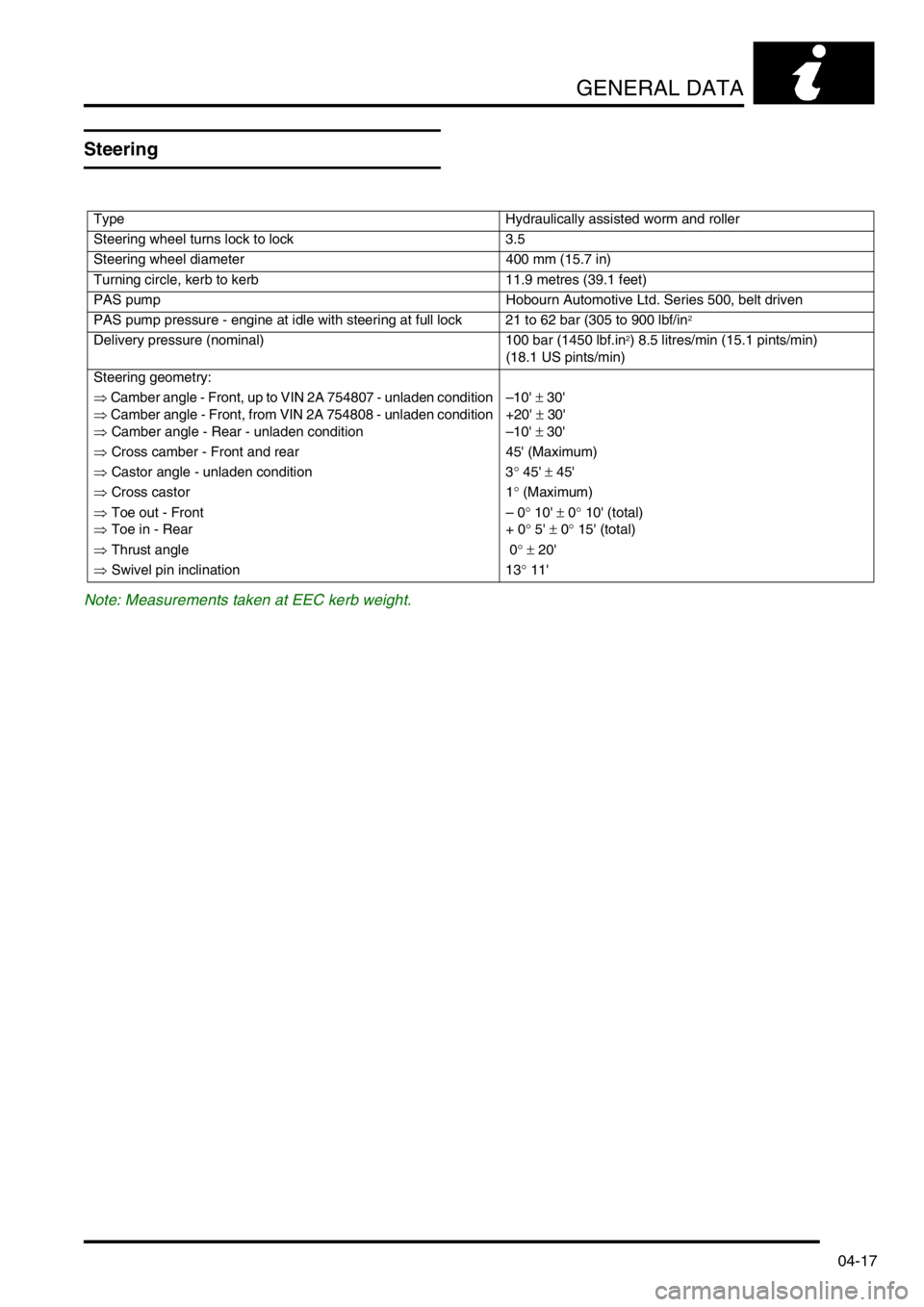engine LAND ROVER DISCOVERY 1999 Owner's Manual
[x] Cancel search | Manufacturer: LAND ROVER, Model Year: 1999, Model line: DISCOVERY, Model: LAND ROVER DISCOVERY 1999Pages: 1529, PDF Size: 34.8 MB
Page 53 of 1529

GENERAL INFORMATION
03-18
Ignition system safety precautions
The vehicle's ignition system produces high voltage
and the following precautions should be observed
before carrying out any work on the system.
WARNING: Before commencing work on an
ignition system, ensure all high tension
terminals, adapters and diagnostic equipment
are adequately insulated and shielded to prevent
accidental personal contacts and minimise the
risk of shock. Wearers of surgically implanted
pacemaker devices should not be in close
proximity of ignition circuits or diagnostic
equipment.
Disciplines
Switch off the ignition prior to making any connection
or disconnection in the system to prevent electrical
surges caused by disconnecting 'live' connections
damaging electronic components.
Ensure hands and work surfaces are clean and free
of grease, swarf, etc. Grease collects dirt which can
cause electrical tracking (short-circuits) or high-
resistance contacts.
When handling printed circuit boards, treat with care
and hold by the edges only; note that some electronic
components are susceptible to body static.
Connectors should never be subjected to forced
removal or refit, especially inter-board connectors.
Damaged contacts can cause short-circuit and open-
circuit fault conditions.
Prior to commencing test, and periodically during a
test, touch a good vehicle body earth to discharge
static charge. Some electronic components are
vulnerable to the static electricity that may be
generated by the operator.
Grease for electrical connectors
Some under bonnet and under body connectors may
be protected against corrosion by the application of a
special grease during vehicle production. Should
connectors be disturbed in service, repaired or
replaced, additional grease should be applied: Part
No. BAU 5811, available in 150 gm tubs.
NOTE: The use of greases other than BAU 5811
must be avoided as they can migrate into relays,
switches etc. contaminating the contacts and leading
to intermittent operation or failure.
Supplementary Restraint System
Precautions
General
The Supplementary Restraint System (SRS)
provides active protection for vehicle occupants in
the event of a serious collision. The system
components include airbags and pretensioner seat
belts which are automatically deployed when a
severe frontal crash condition is detected.
In order to assure system integrity, it is essential that
the SRS system is regularly checked and maintained
so that it is ready for operation in the event of an
accident.
The SRS system contains components which could
be potentially hazardous to the service engineer if
not serviced and handled correctly. The following
guidelines are intended to alert the service engineer
to potential sources of danger and emphasise the
importance of ensuring integrity of the SRS
components fitted to the vehicle.
Where necessary, additional specific precautions are
detailed in the Restraint Systems section of this
Manual which should be referred to prior to
commencing repair operations.
It should be noted that these precautions are not
restricted to operations performed when servicing
the SRS system. The same care should be exercised
when working on ancillary systems and components
located in the vicinity of SRS components; these
include but are not limited to steering system (driver's
airbag), body and trim components (passenger's
airbag and seat belt pretensioners) and electrical
system components (SRS harnesses etc.).
Page 59 of 1529

GENERAL INFORMATION
03-24
Air Conditioning System Precautions
General
The air conditioning system contains fluids and
components which could be potentially hazardous to
the service engineer or the environment if not
serviced and handled correctly. The following
guidelines are intended to alert the service engineer
to potential sources of danger and emphasise the
importance of ensuring the integrity of the Air
Conditioning operating conditions and components
fitted to the vehicle.
Where necessary, additional specific precautions are
detailed in the relevant sections of this Manual which
should be referred to prior to commencing repair
operations.
The refrigerant used in the air conditioning system is
HFC-134a (Hydrofluorocarbon) R134a.
WARNING: Servicing must only be carried out by
personnel familiar with both the vehicle system
and the charging and testing equipment. All
operations must be carried out in a well
ventilated area away from open flame and heat
sources.
WARNING: R134a is a hazardous liquid and when
handled incorrectly can cause serious injury.
Suitable protective clothing, consisting of face
protection, heat proof gloves, rubber boots and
rubber apron or waterproof overalls, must be
worn when carrying out operations on the air
conditioning system.Remedial actions
If an accident involving R134a should occur, conduct
the following remedial actions:
lIf liquid R134a enters the eye, do not rub it.
Gently run large quantities of eye wash over
affected eye to raise the temperature. If an eye
wash is not available, cool, clean water may be
used to flush the eye. After rinsing, cover the
eye with a clean pad and seek immediate
medical attention.
lIf liquid R134a is splashed onto the skin, run
large quantities of water over the affected area
to raise the temperature. Implement the same
action if the skin comes in contact with
discharging cylinders. Wrap the contaminated
body parts in blankets (or similar materials) and
seek immediate medical attention.
lIf the debilitating effects of inhalation of R134a
vapour is suspected, seek fresh air. If the
affected person is unconscious, move them
away from the contaminated area to fresh air
and apply artificial respiration and/or oxygen
and seek immediate medical attention.
WARNING: Due to its low evaporating
temperature, R134a must be handled with care.
R134a splashed on any part of the body will
cause immediate freezing of that area. Also,
refrigerant cylinders and replenishment trolleys
when discharging will freeze skin to them if
contact is made.
Page 62 of 1529

GENERAL INFORMATION
03-27
Body Repairs
General
Body shells are of welded construction and bolted to
a chassis frame. Front and rear sections of the shell
are designed as 'energy absorbing' zones. This
means they are designed to deform progressively
when subjected to impact in order to minimise the
likelihood of injury to vehicle occupants.
It is essential that design dimensions and strength
are restored in accident rectification. It is important
that neither structural weakness nor excessive local
stiffness are introduced into the vehicle during body
repair.
Repairs usually involve a combination of operations
ranging from straightening procedures to renewal of
individual panels or panel assemblies. The repairer
will determine the repair method and this decision will
take into account a balance of economics between
labour and material costs and the availability of repair
facilities in both equipment and skills. It may also
involve considerations of the vehicles' downtime,
replacement vehicle availability and repair turn-
around time.
It is expected that a repairer will select the best and
most economic repair method possible, making use
of the facilities available. The instructions given are
intended to assist a skilled body repairer by
expanding approved procedures for panel
replacement. The objective is to restore the vehicle
to a safe running condition by carrying out a repair
which is as close as is feasible to original standard.
The results should not advertise to the experienced
eye that the vehicle has been damaged, although the
repair might not be identical in all respects to the
original factory build. Commercial bodyshop repair
facilities cannot always duplicate methods of
construction used during production.
Operations covered in this Manual do not include
reference to testing the vehicle after repair. It is
essential that work is inspected and suspension
geometry checked after completion. Where
necessary a road test of the vehicle should be carried
out, particularly where safety-related items are
concerned.
Where major units have been disconnected or
removed it is necessary to ensure that fluid levels are
checked and topped up where necessary. It is also
necessary to ensure that the repaired vehicle is in a
roadworthy condition in respect of tyre pressures,
lights, washer fluid etc. Body repairs often involve the removal of mechanical
and electrical units and associated wiring. Where
necessary, refer to the relevant section of the
Workshop Manual for removal and refitting
instructions.
Taking into consideration the differences in body
styles, suspension systems and engine and
transmission layouts, the location of the following
components as applicable to a particular vehicle is
critical:
lFront suspension upper damper mountings on
RH and LH chassis longitudinals.
lFront suspension or sub frame mountings.
lEngine mountings on RH and LH chassis
longitudinals.
lRear suspension upper damper mountings on
RH and LH chassis longitudinals.
lRear suspension mountings or lower pivots.
Additional points which can be used to check
alignment and assembly are:
lInner holes in cross member - side - main floor.
lHoles in front bulkhead.
lHoles in rear longitudinals.
lHoles in rear lower panels.
Apertures for windscreen, rear screen, bonnet and
doors can be measured and checked using the
dimensional information provided and also by
offering up an undamaged component as a gauge.
Straightening
Whenever possible, structural members should be
cold straightened under tension. Do not attempt to
straighten with a single pull but rework the damaged
area using a series of pulls, releasing tension
between each stage and using the opportunity to
check alignment.
Body jig
Unless damage is limited to cosmetic panels, all
repair work to body members must be carried out on
a body jig, to ensure that impact damage has not
spread into more remote parts of the structure.
Mounting on a jig will also ensure that the
straightening and panel replacement procedures do
not cause further distortion.
If original dimensions cannot be satisfactorily
restored by these methods, damaged structural
members should be replaced. Damaged areas
should be cut away using a high speed saw, NOT an
oxy-acetylene torch.
As a rule, body dimensions are symmetrical about
the centre line. A good initial check for distortion is
therefore to measure diagonally and to investigate
apparent differences in dimensions.
Page 64 of 1529

GENERAL DATA
04-1
GENERAL DATA
Engine - Td5
General
Type 2.5 litre in-line direct injection diesel, turbocharged and intercooled
Cylinder arrangement 5 in-line, No. 1 cylinder at front of engine
Bore 84.450 mm (3.3248 in)
Stroke 88.950 mm (3.5020 in)
Capacity 2498 cm
3 (152.5 in3)
Firing order 1 - 2 - 4 - 5 - 3
Compression ratio 19.5 : 1
Direction of rotation Clockwise viewed from the front of the engine
Dimensions:
⇒ Length 766 mm (30.1 in)
⇒ Width 708 mm (27.8 in)
⇒ Height 788 mm (31.0 in)
Injection timing Controlled by ECM
Injectors:
⇒ Make/Type Lucas EV1/Dual stage
⇒ Injector operating pressures:
Pre EU3 models:
⇒ Initial opening pressure 270 bar (3915 lbf.in
2)
⇒ Fully opened pressure 440 bar (6380 lbf.in
2)
⇒ Maximum pressure 1560 bar (22620 lbf.in
2)
EU3 models:
⇒ Initial opening pressure 270 bar (3915 lbf.in
2)
⇒ Fully opened pressure 440 bar (6380 lbf.in
2)
⇒ Maximum pressure 1750 bar (25375 lbf.in
2)
Maximum governed speed 4850 rev/min
Maximum overrun speed 5460 rev/min
Idle speed:
⇒ Manual gearbox 740 ± 50 rev/min
⇒ Automatic gearbox 760 ± 50 rev/min
Glow plugs Beru 12 V. Four plugs in cylinders 1, 2, 3 and 4
Turbocharger Garrett GT 20
Emissions standard:
⇒ Pre EU3 models ECD 2
⇒ EU3 models ECD 3
Valve timing
Inlet valves:
⇒ Opens 14° BTDC
⇒ Closes 33° ABDC
Exhaust valves:
⇒ Opens 57° BBDC
⇒ Closes 14° ATDC
Page 67 of 1529

GENERAL DATA
04-4
Engine - V8
General
Cylinder arrangement 90° V8, numbered from the front of the engine:
⇒ Left bank cylinders 1, 3, 5 and 7
⇒ Right bank cylinders 2, 4, 6 and 8
Bore 94.00 mm (3.70 in)
Stroke:
⇒ 4.0 litre
⇒ 4.6 litre71.04 mm (2.80 in)
81.92 mm (3.22 in)
Capacity:
⇒ 4.0 litre
⇒ 4.6 litre3950 cm
3 (241 in3)
4554 cm3 (278 in3)
Firing order 1 - 8 - 4 - 3 - 6 - 5 - 7 - 2
Compression ratio:
⇒ Low - 4.0 litre 8.23:1
⇒ High - 4.0 and 4.6 litre 9.35:1
Direction of rotation Clockwise viewed from the front of the engine
Maximum power - 4.0 litre:
⇒ Low compression ratio 132 kW (177 bhp) at 4750 rev/min
⇒ High compression ratio - UK/Japan/ROW 136 kW (182 bhp) at 4750 rev/min
⇒ High compression ratio - NAS 140 kW (187 bhp) at 4750 rev/min
Maximum power - 4.6 litre 162 kW (217 bhp) at 4750 rev/min
Maximum engine speed:
⇒ Continuous5000 rev/min
⇒ Intermittent 5250 rev/min
Weight (fully dressed, wet)
⇒ Manual 194 Kg (435 lb)
⇒ Automatic 179 Kg (402 lb)
Dimensions:
⇒ Length - Manual 767 mm (30.2 in) (Including fan)
⇒ Length - Automatic 777 mm (30.5 in) (Including fan and drive plate)
⇒ Width 652 mm (25.7 in)
⇒ Height 746 mm (29.4 in)
Spark plugs:
⇒ Make/Type - 4.0 litre Champion RC11 PYP B4
⇒ Make/type - 4.6 litre Champion RN11 YCC
⇒ Gap - 4.0 and 4.6 litre 1.00 ± 0.05 mm (0.040 ± 0.002 in) Non-adjustable
Coils:
⇒Make Bosch 0221 503 407
⇒Type Twin coils
Fuel injection system:
⇒Make Bosch Motronic 5.2.1 Type 4146
⇒Type Multiport fuel injection, electronically controlled with electro-
mechanical injectors
Page 70 of 1529

GENERAL DATA
04-7
Valves
Stem diameter:
⇒ Inlet 8.664 - 8.679 mm (0.3411 - 0.3417 in)
⇒ Exhaust – 4.0 litre up to engine nos. 55D 05677A;
56D 50787A; 97D 05504A
⇒ Exhaust – 4.0 litre from engine nos. 55D 05678A;
56D 50788A; 97D 05505A and all 4.6 litre8.651 - 8.666 mm (0.3406 - 0.3412 in)
8.641 to 8.656 mm (0.340 to 0.341 in)
Head diameter:
⇒ Inlet 39.75 - 40.00 mm (1.5650 - 1.5748 in)
⇒ Exhaust 34.227 - 34.481 mm (1.3475 - 1.3575 in)
Seat face angle:
⇒ Inlet 46° 25' - 46° 00'
⇒ Exhaust 46° 25' - 46° 00'
Valve face angle:
⇒ Inlet 45° 00' - 45° 30'
⇒ Exhaust 45° 00' - 45° 30'
Valve springs
Free length 48.8 mm (1.92 in)
Fitted length 40.93 mm (1.61 in)
Page 72 of 1529

GENERAL DATA
04-9
Cooling system - Td5
Type Pressurised, spill return partial flow, thermostatically controlled
Cooling fans 11 blade axial flow on viscous coupling and 11 blade axial flow electric
Electric cooling fan switching points:
For A/C system:
⇒ On When vehicle speed is 50 mph (80 km/h) or less and ambient
temperature is 28 °C (82 °F) or more
⇒ Off When vehicle speed increases to 62.5 mph (100 km/h) or ambient
temperature decreases to 25 °C (77 °F)
For engine cooling during normal running:
⇒ On 110 °C (230 °F)
⇒ Off 105 °C (221 °F)
For engine cooling at ignition off (to counteract heat
soak):
⇒ On If, within 10 seconds of ignition off, engine coolant temperature is 105
°C (221 °F) or more
⇒ Off After 10 minutes or if engine coolant temperature decreases to 100 °C
(212 °F)
Coolant pump Centrifugal impeller, belt driven from crankshaft
Thermostat Waxstat with pressure relief valve
Thermostat opening temperature:
⇒ Initial opening 82 °C (179 °F)
⇒ Fully open 96 °C (204 °F)
Expansion tank cap relief valve - system operating
pressure1.4 bar (20.3 lbf.in
2)
Fuel cooler thermostat opening temperature 82°C (179°F)
Page 73 of 1529

GENERAL DATA
04-10
Cooling system - V8
Type Pressurised, spill return, thermostatically controlled water and
antifreeze mixture. Vertical flow radiator with remote header tank and
pump assisted
Cooling fans 9 blade axial flow on viscous coupling and 11 blade axial flow electric
Electric cooling fan switching points:
For A/C system:
⇒ On When vehicle speed is 50 mph (80 km/h) or less and ambient
temperature is 28 °C (82 °F) or more
⇒ Off When vehicle speed increases to (62.5 mph (100 km/h) or ambient
temperature decreases to 25 °C (77 °F)
For engine cooling during normal running:
⇒ On 100 °C (212 °F)
⇒ Off 94.5 °C (202 °F)
For engine cooling at ignition off (to counteract heat
soak):
⇒ On If, within 10 seconds of ignition off, intake air temperature is 60 °C (140
°F) or more and engine coolant temperature is 110 °C (230 °F) or more
⇒ Off After 10 minutes or if engine coolant temperature decreases to 100 °C
(212 °F)
Coolant pump Centrifugal impeller, belt driven from crankshaft
Coolant pump drive ratio 1.293 : 1
Coolant pump output at 1000 rev/min 10 litres/min (2.64 US galls/min) at 0.7 bar (10 lbf.in
2)
Thermostat Waxstat with pressure relief valve
Thermostat operating temperature:
⇒ Initial opening 82 °C (179 °F)
⇒ Fully open 96 °C (204 °F)
Expansion tank cap relief valve - system operating
pressure1.4 bar (20 lbf.in
2)
Page 80 of 1529

GENERAL DATA
04-17
Steering
Note: Measurements taken at EEC kerb weight.
Type Hydraulically assisted worm and roller
Steering wheel turns lock to lock 3.5
Steering wheel diameter 400 mm (15.7 in)
Turning circle, kerb to kerb 11.9 metres (39.1 feet)
PAS pump Hobourn Automotive Ltd. Series 500, belt driven
PAS pump pressure - engine at idle with steering at full lock 21 to 62 bar (305 to 900 lbf/in
2
Delivery pressure (nominal) 100 bar (1450 lbf.in2) 8.5 litres/min (15.1 pints/min)
(18.1 US pints/min)
Steering geometry:
⇒ Camber angle - Front, up to VIN 2A 754807 - unladen condition
⇒ Camber angle - Front, from VIN 2A 754808 - unladen condition
⇒ Camber angle - Rear - unladen condition–10' ± 30'
+20' ± 30'
–10' ± 30'
⇒ Cross camber - Front and rear 45' (Maximum)
⇒ Castor angle - unladen condition 3° 45' ± 45'
⇒ Cross castor 1° (Maximum)
⇒ Toe out - Front
⇒ Toe in - Rear– 0° 10' ± 0° 10' (total)
+ 0° 5' ± 0° 15' (total)
⇒ Thrust angle 0° ± 20'
⇒ Swivel pin inclination 13° 11'
Page 87 of 1529

GENERAL DATA
04-24
Weights
NOTE: The rear axle load for vehicles with self levelling suspension can be increased to a maximum of 1928 kg (4249
lb) when towing, provided road speed is limited to 60 mph (100 km/h).
NOTE: Axle weights are non additive. The individual maximum weights and gross vehicle weight must not be
exceeded.
kgs lbs
Unladen weight:
⇒ V8 models 2095 - 2235 4619 - 4928
⇒ Td5 model 2150 - 2280 4740 - 5027
Max.GVW:
⇒ All 5 seat vehicles (coil springs) 2750 6063
⇒ All 7 seat Diesel engine vehicles (coil springs) 2880 6347
⇒ All 7 seat Petrol engine vehicles (coil springs) 2825 6215
⇒ V8 models with self levelling suspension 2825 6228
⇒ Td5 models with self levelling suspension 2880 6349
Max. front axle load 1200 2646
Max. rear axle load:
⇒ With coil springs 1720 3792
⇒ With self levelling suspension 1800 3968